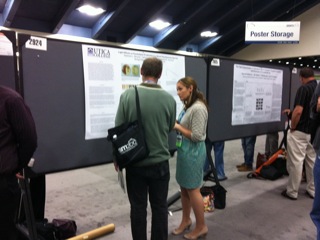
Light Effects on Pyomelanin Production in a Novel Pseudomonas Species
S. L. Benzing, C. C. Cotrupe, L. R. Aaronson;
Some Pseudomonas species produce pyomelanin in order to protect the cell against damage from ultraviolet light. Several years ago we isolated a novel species of Pseudomonas that produces a dark reddish-brown pigment on nutrient-rich media. This pigment is dependent on tyrosine in the medium, and has been identified as pyomelanin (PM). Recent work in our lab showed that PM production also is light-dependent and not produced when bacteria are grown in complete darkness. To further investigate photoinduction of PM in a novel Pseudomonas species. This two-part study focused on quantifying the effects of light intensity and the length of exposure to light on PM production. Pseudomonas sp. UC17F4 was cultured at high and low density on TSYE agar plates. The goal of the first part of the study was to control the amount of time the bacteria were subjected to a constant light intensity (300 lux). The plates were subjected to light in intervals, from 5 to 45 min., with plates remaining in complete darkness and in 300 lux for 24 hours as controls. The second part of the study focused on varying light intensities over a constant time period. Freshly spread plates were placed under lights at 100, 200, 250, and 300 lux (with a control in complete darkness) for 24 hours. After incubation, bacteria were suspended by gently scraping the bacteria off the agar in PBS. The samples were centrifuged to pellet the cells, which were then weighed. Cell pellets were resuspended in 1% SDS and disrupted by boiling. Cell lysates were analyzed by UV spectrometry and data were expressed as A335U/g wet wt. PM production tended to be dependent on the density of cells, with more PM produced in cells plated at higher density. A two-fold increase of PM content was exhibited in time exposures up to 35 min. The light intensity study showed an increase of melanin up to 250 lux. Lastly, it was shown that a significant amount PM was produced in the dark controls. The results show that PM production is dependent on the duration of exposure to light and on the light intensity. The fact that PM production declines above 250 lux suggests that photobleaching may occur. Also, the fact that time- and intensity-dependent changes in PM levels were of lesser magnitude suggests that quorum sensing may also induce PM production in this organism

